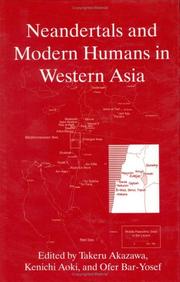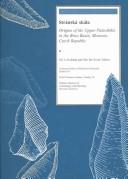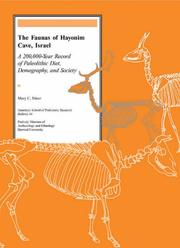Article
Abstract | Keywords | Export | Availability | Bookmark
 Loading...
Loading...Choose an application
- Reference Manager
- EndNote
- RefWorks (Direct export to RefWorks)

ISBN: 0306459248 9780306459245 128020706X 9786610207060 0306471531 Year: 1998 Publisher: New York : Kluwer Academic Publishers,
Abstract | Keywords | Export | Availability | Bookmark
 Loading...
Loading...Choose an application
- Reference Manager
- EndNote
- RefWorks (Direct export to RefWorks)
In this fascinating volume, the Middle Paleolithic archaeology of the Middle East is brought to the current debate on the origins of modern humans. These collected papers gather the most up-to-date archaeological discoveries of Western Asia - a region that is often overshadowed by African or European findings - but the only region in the world where both Neandertal and early modern human fossils have been found. The collection includes reports on such well known cave sites as Kebara, Hayonim, and Qafzeh, among others. The information and interpretations available here are a must for any serious researcher or student of anthropology or human evolution.
Hominids --- Neanderthals --- Homme de Néanderthal --- Hominidés --- Middle East --- Asia --- Moyen-Orient --- Asie --- Antiquities. --- Antiquités --- EPUB-LIV-FT SPRINGER-B --- Asia -- Antiquities. --- Hominids -- Asia. --- Hominids -- Middle East. --- Middle East -- Antiquities. --- Neanderthals -- Asia. --- Neanderthals -- Middle East. --- Social sciences. --- Life sciences. --- Archaeology. --- Social Sciences. --- Life Sciences, general. --- Biosciences --- Sciences, Life --- Science --- Archeology --- Anthropology --- Auxiliary sciences of history --- History --- Antiquities --- Great apes --- Hominians --- Hominidae --- Homininae --- Hominins --- Homonids --- Man-like primates --- Pongidae --- Apes --- Primates --- Homo mousteriensis --- Homo neanderthalensis --- Homo primogenicus --- Homo sapiens neanderthalensis --- Neandertalers --- Neandertals --- Neanderthal race --- Neanderthalers --- Fossil hominids
Book
ISBN: 9781402085390 1402085389 9781402085383 9048179068 9786611810870 1281810878 1402085397 Year: 2008 Publisher: [Dordrecht]: Springer,
Abstract | Keywords | Export | Availability | Bookmark
 Loading...
Loading...Choose an application
- Reference Manager
- EndNote
- RefWorks (Direct export to RefWorks)
Using cemetery data, it has been possible to identify the signature of a previously unknown demographic process associated with the transition from a hunter-gatherer to an agricultural economy. Characterized by a dramatic increase in the birth rate, and consequently of the population growth rate, over a period of less than a millennium following the transition to agriculture, this global demographic process has been termed the Neolithic Demographic Transition (NDT). The NDT signature has so far been detected in Europe, North America, Mesoamerica and South America. The methodological innovation which has made possible the identification of the NDT is the use of a relative chronology, fixed to the local onset of the Neolithic. That is, events are considered not in terms of their absolute calendar dates, but rather in terms of their relation to the local date of the transition to agriculture. This volume presents and discusses the consequences and implications of the NDT on a global scale. Topics include: The causes of the NDT at its onset; Indicators of economic intensification as related to the NDT; Settlement and village practices associated with the pace of the NDT; The emergence of social practices associated with larger population concentrations; The effects of increased population density on human health.
History --- archeologie --- Ethnology. Cultural anthropology --- demografie --- Demography --- geschiedenis --- Archeology --- Neolithic period --- Néolithique --- Démographie --- EPUB-LIV-FT LIVHUMAI SPRINGER-B --- Demography. --- History. --- Archaeology. --- Anthropology. --- History, general. --- Human beings --- Anthropology --- Auxiliary sciences of history --- Antiquities --- Annals --- Historical demography --- Social sciences --- Population --- Vital statistics --- Primitive societies --- Neolithic period. --- Demographic transition.
Book
ISBN: 1315421208 1315421216 1611327776 9781611327779 9781611327496 1611327490 9781598745900 1598745905 1315421194 Year: 2016 Publisher: Abingdon, Oxon : Routledge,
Abstract | Keywords | Export | Availability | Bookmark
 Loading...
Loading...Choose an application
- Reference Manager
- EndNote
- RefWorks (Direct export to RefWorks)
This volume is a major revision and expansion of Taylor's seminal book Radiocarbon Dating: An Archaeological Perspective. It covers the major advances and accomplishments of the 14C method in archaeology and analyzes factors that affect the accuracy and precision of 14C-based age estimates. In addition to reviewing the basic principles of the method, it examines 14C dating anomalies and means to resolve them, and considers the critical application of 14C data as a dating isotope with special emphasis on issues in Old and New World archaeology and late Quaternary paleoanthropology. This volume,
Archaeological dating. --- Radiocarbon dating. --- Carbon dating --- Carbon-14 dating --- Dating, Radiocarbon --- Archaeological dating --- Radioactive dating --- Archaeology --- Dating in archaeology --- Dating --- Methodology
Book
ISBN: 9652780324 Year: 1985 Publisher: Yerushalayim : Muzeʼon Yiśraʼel,
Abstract | Keywords | Export | Availability | Bookmark
 Loading...
Loading...Choose an application
- Reference Manager
- EndNote
- RefWorks (Direct export to RefWorks)
Archeology --- archaeology --- Israel --- Archaeology --- Anthropology --- Auxiliary sciences of history --- History --- Antiquities --- Judea, Wilderness of --- Barrīyat al Yahūdīyah --- Jeshimmon --- Judaea, Wilderness of (Israel and Jordan) --- Judean Desert --- Midbar Yehuda --- Midbar Yehudah --- Wilderness of Judaea --- Wilderness of Judah --- Wilderness of Judea --- Yeshimon --- Antiquities. --- Exhibitions --- Barrīyat al Quds --- Jeshimon --- Judah, Wilderness of --- Judaea, Wilderness of --- Quds, Barrīyat al --- Yahūdīya, Barrīyat al --- Yehuda Desert --- Yehudah Desert
Book
Year: 1977 Publisher: Jerusalem: Hebrew University of Jerusalem. Institute of archaeology,
Abstract | Keywords | Export | Availability | Bookmark
 Loading...
Loading...Choose an application
- Reference Manager
- EndNote
- RefWorks (Direct export to RefWorks)
Digital
ISBN: 9781402085390 Year: 2008 Publisher: Dordrecht Springer Science+Business Media B.V
Abstract | Keywords | Export | Availability | Bookmark
 Loading...
Loading...Choose an application
- Reference Manager
- EndNote
- RefWorks (Direct export to RefWorks)
Demography --- Ethnology. Cultural anthropology --- Archeology --- History --- demografie --- geschiedenis --- archeologie --- Stone age --- Prehistory

ISBN: 0873655516 Year: 2003 Volume: 47 v. 10 Publisher: Cambridge, Mass. : Peabody Museum of Archaeology and Ethnology, Harvard University,
Abstract | Keywords | Export | Availability | Bookmark
 Loading...
Loading...Choose an application
- Reference Manager
- EndNote
- RefWorks (Direct export to RefWorks)
Aurignacian culture --- Tools, Prehistoric --- Excavations (Archaeology) --- Aurignacien --- Outils préhistoriques --- Fouilles (Archéologie) --- Stránska Skála Site (Czech Republic) --- Brno Region (Czech Republic) --- Stránska Skála(République tchèque : Site archéologique) --- Brno, Région de (République tchèque) --- Antiquities. --- Antiquités

ISBN: 0873655524 Year: 2005 Volume: 48. Publisher: Cambridge, Mass. : Peabody Museum of Archaeology and Ethnology, Harvard University,
Abstract | Keywords | Export | Availability | Bookmark
 Loading...
Loading...Choose an application
- Reference Manager
- EndNote
- RefWorks (Direct export to RefWorks)
Mousterian culture --- Paleolithic period --- Prehistoric peoples --- Excavations (Archaeology) --- Animal remains (Archaeology) --- Moustérien --- Paléolithique --- Homme préhistorique --- Fouilles (Archéologie) --- Restes d'animaux (Archéologie) --- Food --- Alimentation --- Hayonim Cave (Israel) --- Meged Rockshelter (Israel) --- Galilee (Israel) --- Hayonim, Grotte de (Israël) --- Meged, Abri-sous-roche de (Israël) --- Galilée (Israël) --- Antiquities. --- Antiquités
Book
Year: 1977 Volume: 7 Publisher: Jerusalem : The Institute of Archaeology, The Hebrew University,
Abstract | Keywords | Export | Availability | Bookmark
 Loading...
Loading...Choose an application
- Reference Manager
- EndNote
- RefWorks (Direct export to RefWorks)
Archaeological expeditions --- Expéditions archéologiques --- Gebel Maghara --- Sinaitic Peninsula --- Antiquities

 Search
Search Feedback
Feedback About UniCat
About UniCat  Help
Help News
News